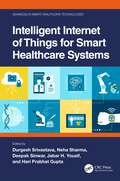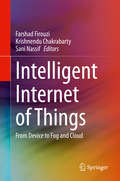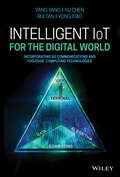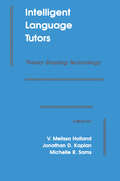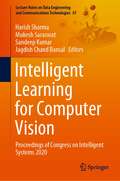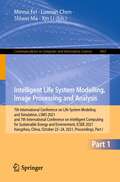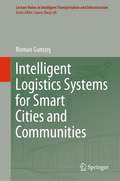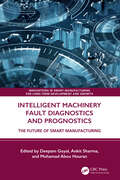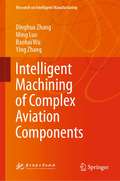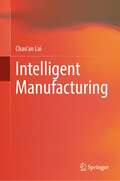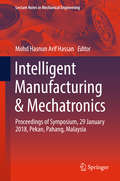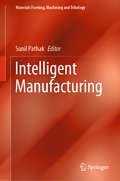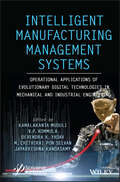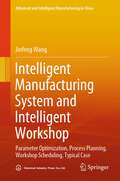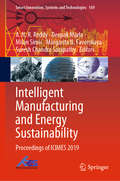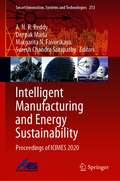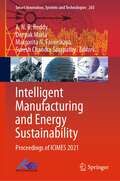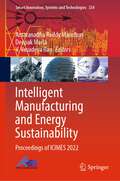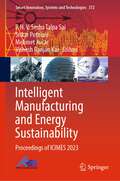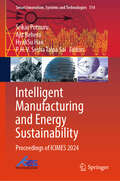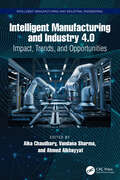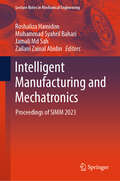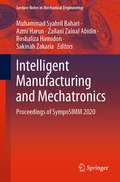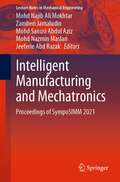- Table View
- List View
Intelligent Internet of Things for Smart Healthcare Systems (Advances in Smart Healthcare Technologies)
by Neha Sharma Deepak Sinwar Durgesh Srivastava Jabar H. Yousif Hari Prabhat GuptaThe book focuses on developments in artificial intelligence (AI) and internet of things (IoT) integration for smart healthcare, with an emphasis on current methodologies and frameworks for the design, growth, implementation, and creative use of such convergence technologies to provide insight into smart healthcare service demands. Concepts like signal recognition, computation, internet of health stuff, and so forth and their applications are covered. Development in connectivity and intelligent networks allowing for social adoption of ambient intelligence is also included. Features:•Introduces Intelligent IoT as applicable to the key areas of smart healthcare.•Discusses computational intelligence and IoT-based optimizations of smart healthcare systems•Explores effective management of healthcare systems using dedicated IoT-based infrastructures•Includes dedicated chapters on securing patient’s confidential data •Reviews diagnosis of critical diseases from medical imaging using advanced deep learning-based approaches This book is aimed at researchers, professionals, and graduate students in intelligent systems, big data, cloud computing, information security, and healthcare systems.
Intelligent Internet of Things: From Device to Fog and Cloud
by Krishnendu Chakrabarty Farshad Firouzi Sani NassifThis holistic book is an invaluable reference for addressing various practical challenges in architecting and engineering Intelligent IoT and eHealth solutions for industry practitioners, academic and researchers, as well as for engineers involved in product development. The first part provides a comprehensive guide to fundamentals, applications, challenges, technical and economic benefits, and promises of the Internet of Things using examples of real-world applications. It also addresses all important aspects of designing and engineering cutting-edge IoT solutions using a cross-layer approach from device to fog, and cloud covering standards, protocols, design principles, reference architectures, as well as all the underlying technologies, pillars, and components such as embedded systems, network, cloud computing, data storage, data processing, big data analytics, machine learning, distributed ledger technologies, and security. In addition, it discusses the effects of Intelligent IoT, which are reflected in new business models and digital transformation. The second part provides an insightful guide to the design and deployment of IoT solutions for smart healthcare as one of the most important applications of IoT. Therefore, the second part targets smart healthcare-wearable sensors, body area sensors, advanced pervasive healthcare systems, and big data analytics that are aimed at providing connected health interventions to individuals for healthier lifestyles.
Intelligent IoT for the Digital World: Incorporating 5G Communications and Fog/Edge Computing Technologies
by Yang Yang Xu Chen Rui Tan Yong XiaoDiscover how the Internet of Things will change the information and communication technology industry in the next decade The Intelligent Internet of Things explores a unique type of Internet of Things (IoT) architecture, for example, the Web of Things (WoT) with its open character that breaks the barriers among various IoT vertical applications. The authors—noted experts on the topic—examine and compare key technologies from physical to platform level, especially the Narrow Band Internet of Things (NB-IoT) technology. They discuss applications with different data transmission requirements that are typical to IoT. The text also describes the requirements of WoT applications on 5G and includes detailed information on WoT technologies. The Intelligent Internet of Things examines three typical WoT applications: the monitoring application of south-to-north water diversion projects; smart driving applications; and network optimization applications. In addition, the text explores testing and authentication of IoT key technologies, with the required equipment, platform, and outdoor environment development. This important book: Provides information on what IoT/WoT is, when to use it, how to provide IoT services with certain technologies, and more Discusses restful architecture, main protocols (ZigBee, 6lowpan, CoAP, HTML5) Explores key technologies on different layers (sensing, gathering, application) Examines how IoT will change the information and communication technology industry Written for professionals working in IoT development, management and big data analytics, Intelligent Internet of Things offers an overview of IoT architecture, key technology, current applications and future development of the technology.
Intelligent Language Tutors: Theory Shaping Technology
by V. Melissa Holland Jonathan D. Kaplan Michelle R. SamsThe techniques of natural language processing (NLP) have been widely applied in machine translation and automated message understanding, but have only recently been utilized in second language teaching. This book offers both an argument for and a critical examination of this new application, with an examination of how systems may be designed to exploit the power of NLP, accomodate its limitations, and minimize its risks. This volume marks the first collection of work in the U.S. and Canada that incorporates advanced human language technologies into language tutoring systems, covering languages as diverse as Arabic, Spanish, Japanese, and English. The book is organized into sections that express the levels of analysis dealt with in learning and teaching a language and with the tasks of the student as writer, reader, conversant, and actor in the world. These sections bring together research by specialists in linguistics, artificial intelligence, psychology, instructional design, and language teaching. In addition to providing detailed descriptions of working systems, amply illustrated with screens from lesson and authoring interfaces, the contributors address a spectrum of common issues: * What can current NLP technology contribute to computer-assisted language instruction and to research on language learning? * How can this technology meet the demands of pedagogical theory for communicative language teaching in authentic contexts? * How can designers constrain tutoring environments to ensure accurate analysis of learners' language? * What can NLP-based systems teach us about language acquisition, about linguistic theory, and about theories of language pedagogy? * What lessons have been learned in using these systems to date? Discipline-specific issues are illuminated as well: the relative merits of the major syntactic frameworks for NLP-based language tutoring; the adaptation of theories like lexical conceptual structure to support semantic interpretation; the integration of input language with visual microworlds and dialogue games; the pragmatics of the tutoring discourse; the selection of instructional principles to guide system design; and the accomodation of design to individual differences and learner styles. A concluding section assesses this work from larger theoretical and practical perspectives -- experimental psychology and psycholinguistics, linguistics, language teaching, and second language acquisition research.
Intelligent Learning for Computer Vision: Proceedings of Congress on Intelligent Systems 2020 (Lecture Notes on Data Engineering and Communications Technologies #61)
by Sandeep Kumar Jagdish Chand Bansal Harish Sharma Mukesh SaraswatThis book is a collection of selected papers presented at the First Congress on Intelligent Systems (CIS 2020), held in New Delhi, India, during September 5–6, 2020. It includes novel and innovative work from experts, practitioners, scientists, and decision-makers from academia and industry. It covers selected papers in the area of computer vision. This book covers new tools and technologies in some of the important areas of medical science like histopathological image analysis, cancer taxonomy, use of deep learning architecture in dental care, and many more. Furthermore, this book reviews and discusses the use of intelligent learning-based algorithms for increasing the productivity in agricultural domain.
Intelligent Life System Modelling, Image Processing and Analysis: 7th International Conference on Life System Modeling and Simulation, LSMS 2021 and 7th International Conference on Intelligent Computing for Sustainable Energy and Environment, ICSEE 2021, Hangzhou, China, October 30 – November 1, 2021, Proceedings, Part I (Communications in Computer and Information Science #1467)
by Xin Li Minrui Fei Shiwei Ma Luonan ChenThis three-volume set CCIS 1467, CCIS 1468, and CCIS 1469 constitutes the thoroughly refereed proceedings of the 7th International Conference on Life System Modeling and Simulation, LSMS 2021, and of the 7th International Conference on Intelligent Computing for Sustainable Energy and Environment, ICSEE 2021, held in Hangzhou, China, in October 2021. The 159 revised papers presented were carefully reviewed and selected from over 430 submissions.The papers of this volume are organized in topical sections on: Medical Imaging and Analysis Using Intelligence Computing; Biomedical signal processing, imaging, visualization and surgical robotics; Computational method in taxonomy study and neural dynamics; Intelligent medical apparatus, clinical applications and intelligent design of biochips; Power and Energy Systems; Computational Intelligence in Utilization of Clean and Renewable Energy Resources, and Intelligent Modelling, Control and Supervision for Energy Saving and Pollution Reduction; Intelligent Methods in Developing Electric Vehicles, Engines and Equipment; Intelligent Control Methods in Energy Infrastructure Development and Distributed Power Generation Systems; Intelligent Modeling, Simulation and Control of Power Electronics and Power Networks; Intelligent Techniques for Sustainable Energy and Green Built Environment, Water Treatment and Waste Management; Intelligent Robot and Simulation; Intelligent Data Processing, Analysis and Control in Complex Systems; Advanced Neural Network Theory and Algorithms; Advanced Computational Methods and Applications; Fuzzy, Neural, and Fuzzy-neuro Hybrids; Intelligent Modelling, Monitoring, and Control of Complex Nonlinear Systems; Intelligent manufacturing, autonomous systems, intelligent robotic systems; Computational Intelligence and Applications.
Intelligent Logistics Systems for Smart Cities and Communities (Lecture Notes in Intelligent Transportation and Infrastructure)
by Roman GumzejThis book sets the modern infrastructure of smart devices and services into the perspective of the future smart cities and communities. In the course of this, it discusses the major technological solutions and steps toward integrated logistics solutions to be used in these environments with their benefits in terms of efficiency, interoperability, and sustainability. By doing so, it paves the logistician’s way toward the aspired innovation society.
Intelligent Machinery Fault Diagnostics and Prognostics: The Future of Smart Manufacturing (Innovations in Smart Manufacturing for Long-Term Development and Growth)
by Ankit Sharma Mohamad Abou HouranThe field of machinery maintenance is undergoing a remarkable transformation, driven by the convergence of intelligent technologies and data-driven approaches. This book delves into the fascinating world of intelligent machinery fault diagnostics and prognostics, exploring how these advancements are reshaping the way we monitor, diagnose, and predict faults in machinery.Intelligent Machinery Fault Diagnostics and Prognostics: The Future of Smart Manufacturing uses an interdisciplinary approach to provide a well-rounded understanding of smart manufacturing. It discusses cutting-edge smart manufacturing technologies and encompasses various aspects, from sensors and data analytics to predictive maintenance. The book offers real-world case studies illustrating how these innovations are successfully implemented in industrial settings and includes practical guidelines and methodologies that facilitate the implementation of solutions.The book also highlights the scalability and adaptability of this approach to different industries and manufacturing environments. Whether this book is for industry professionals, students, or researchers, readers can leverage the book’s insights to optimize machinery performance, minimize downtime, reduce costs, and improve safety in their respective industries.
Intelligent Machining of Complex Aviation Components (Research on Intelligent Manufacturing)
by Ying Zhang Dinghua Zhang Ming Luo Baohai WuThis book discusses the basic theoretical model and implementation method of intelligent machining technology and promotes the application of intelligent machining technology in the manufacturing of complex aviation components, such as aero-engine blisk, casing parts and blades. It not only presents the fundamental theory of intelligent machining, but also provides detailed examples of applications in the aviation industry.The topics covered include intelligent programming, intelligent processing models, process monitoring, machining process control, intelligent fixtures and applications in aviation components machining.This book is intended for researchers, engineers and postgraduate students in fields of manufacturing, mechatronics, mechanical engineering and related areas.
Intelligent Manufacturing
by Chao'an LaiThis book introduces intelligent manufacturing system planning, design, and implementation, through the deep integration of the Internet, big data, artificial intelligence, and manufacturing process, to promote the transformation and upgrading of enterprises. This book shows the implementation of intelligent manufacturing process with 12 benchmarking enterprises, discusses the planning, implementation, and control of intelligent manufacturing system technology and method of theory, and analyzes the five hierarchies of intelligent manufacturing system, the five stages of life cycle, and five kinds of intelligent depth. The content can cultivate the reader's vocational ability to develop intelligent solutions and implementation based on complex, uncertain environment needs. This book will be interesting and useful to a wide readership in the various fields of management, information science, and engineering science.
Intelligent Manufacturing & Mechatronics: Proceedings Of Symposium, 29 January 2018, Pekan, Pahang, Malaysia (Lecture Notes In Mechanical Engineering)
by Mohd Hasnun HassanThis book presents the proceedings of SympoSIMM 2018, the 1st edition of the Symposium on Intelligent Manufacturing and Mechatronics. With the theme of “Strengthening Innovations Towards Industry 4.0”, the book comprises the studies towards the particularity of Industry 4.0’s current trends. It is divided into five parts covering various scopes of manufacturing engineering and mechatronics stream, namely Intelligent Manufacturing, Robotics, Artificial Intelligence, Instrumentation, and Modelling and Simulation. It is hoped that this book will benefit the readers in embracing the new era of Industrial Revolution 4.0.
Intelligent Manufacturing (Materials Forming, Machining and Tribology)
by Sunil PathakThis book sheds light on the development of traditional and advanced optimization methods. Their use in various tradition and non-tradition manufacturing and machining processes for an improved manufacturability is reported. This includes key elements of implementing conventional statistical methods, multi-objective and multi-criteria decision-making methods and evolution of single and multi-target optimization techniques using soft computing to enhance production performance, efficiency and sustainability in manufacturing. The latest research in this area as well as possible avenues of future research are also highlighted.
Intelligent Manufacturing Management Systems: Operational Applications of Evolutionary Digital Technologies in Mechanical and Industrial Engineering (Advances In Intelligent Decision-making, Systems Engineering, And Project Management Ser.)
by Jayakrishna Kandasamy Kamalakanta Muduli V. P. Kommula Devendra K. Yadav M. Chithirai Pon SelvanINTRELLIGENT MANUFACTURING MANAGEMENT SYSTEMS The book explores the latest manufacturing techniques in relation to AI and evolutionary algorithms that can monitor and control the manufacturing environment. The concepts that pertain to the application of digital evolutionary technologies in the sphere of industrial engineering and manufacturing are presented in this book. A few chapters demonstrate stepwise discussion, case studies, structured literature review, rigorous experimentation results, and applications. Further chapters address the challenges encountered by industries in integrating these digital technologies into their operational activities, as well as the opportunities for this integration. In addition, the reader will find: Systemic explanations of the unique characteristics of big data, cloud computing, and AI used for decision-making in intelligent production systems; Highlights of the current and highly relevant topics in manufacturing management; Structured presentations resolving the issues being faced by many real-world applications in a broad range of areas such as smart supply chains, knowledge management, intelligent inventory management, IoT adoption in manufacturing management, and more; Intelligent techniques for sustainable practices in industrial waste management. Audience The book will be used by researchers, industry engineers, and data scientists/AI specialists working in industrial engineering, mechanical engineering, production engineering, manufacturing engineering, and operations and supply chain management. The book will also be valuable to the service sector industry, such as logistics and those implementing smart cities.
Intelligent Manufacturing System and Intelligent Workshop: Parameter Optimization, Process Planning, Workshop Scheduling, Typical Case (Advanced and Intelligent Manufacturing in China)
by Jinfeng WangThis book focuses on the basic common technologies of smart manufacturing system and smart workshop. The applications of artificial intelligence in manufacturing system have been addressed from different perspectives, for example, smart optimization of cutting parameters, smart process planning, smart workshop and scheduling, and smart integration of process planning and scheduling. In the process of writing, this book highlights the combination of basic theory and engineering practice. In the basic theory part, the book clearly explains the basic issues of smart manufacturing system, including the core support technology of smart manufacturing, the basic theories and models of cutting parameter optimization, process optimization and scheduling, and the basic concepts and intelligence of smart manufacturing workshop model, optimization methods, etc. In the engineering practice part, this book enumerates a large number of research cases, trying to clearly demonstrate the basic problems of manufacturing system intelligence, and each chapter is accompanied by typical cases to help readers better understand and master the basic theories involved in stamping.
Intelligent Manufacturing Systems in Industry 4.0: Select Proceedings of IPDIMS 2022 (Lecture Notes in Mechanical Engineering)
by B. B. Biswal B. B. V. L. Deepak D. R. K. Parhi M. V. A. Raju BahubalendruniThis book presents the select proceedings of the 4th International Conference on Innovative Product Design and Intelligent Manufacturing System (IPDIMS 2022). It covers the latest trends in the areas of design and manufacturing. The main topics covered include Industry 4.0, smart manufacturing, advanced robotics, and CAD/CAM/CIM. The contents of this book are useful for researchers and professionals working in the disciplines of mechatronics, mechanical, manufacturing, production, and industrial engineering.
Intelligent Manufacturing and Energy Sustainability: Proceedings of ICIMES 2019 (Smart Innovation, Systems and Technologies #169)
by Margarita N. Favorskaya Suresh Chandra Satapathy A. N. R. Reddy Deepak Marla Milan SimicThis book includes selected, high-quality papers presented at the International Conference on Intelligent Manufacturing and Energy Sustainability (ICIMES 2019) held at the Department of Mechanical Engineering, Malla Reddy College of Engineering & Technology (MRCET), Maisammaguda, Hyderabad, India, from 21 to 22 June 2019. It covers topics in the areas of automation, manufacturing technology and energy sustainability.
Intelligent Manufacturing and Energy Sustainability: Proceedings of ICIMES 2020 (Smart Innovation, Systems and Technologies #213)
by Margarita N. Favorskaya Suresh Chandra Satapathy A. N. R. Reddy Deepak MarlaThis book includes best selected, high-quality research papers presented at the International Conference on Intelligent Manufacturing and Energy Sustainability (ICIMES 2020) held at the Department of Mechanical Engineering, Malla Reddy College of Engineering & Technology (MRCET), Maisammaguda, Hyderabad, India, during August 21-22, 2020. It covers topics in the areas of automation, manufacturing technology and energy sustainability and also includes original works in the intelligent systems, manufacturing, mechanical, electrical, aeronautical, materials, automobile, bioenergy and energy sustainability.
Intelligent Manufacturing and Energy Sustainability: Proceedings of ICIMES 2021 (Smart Innovation, Systems and Technologies #265)
by Margarita N. Favorskaya Suresh Chandra Satapathy A. N. R. Reddy Deepak MarlaThis book includes best selected, high-quality research papers presented at the International Conference on Intelligent Manufacturing and Energy Sustainability (ICIMES 2021) held at the Department of Mechanical Engineering, Malla Reddy College of Engineering & Technology (MRCET), Maisammaguda, Hyderabad, India, during June 18-19, 2021. It covers topics in the areas of automation, manufacturing technology and energy sustainability and also includes original works in the intelligent systems, manufacturing, mechanical, electrical, aeronautical, materials, automobile, bioenergy and energy sustainability.
Intelligent Manufacturing and Energy Sustainability: Proceedings of ICIMES 2022 (Smart Innovation, Systems and Technologies #334)
by Deepak Marla Amaranadha Reddy Manchuri V. Vasudeva RaoThis book includes best selected, high-quality research papers presented at the International Conference on Intelligent Manufacturing and Energy Sustainability (ICIMES 2022) held at the Department of Mechanical Engineering, Malla Reddy College of Engineering & Technology (MRCET), Maisammaguda, Hyderabad, India, during June 24–25, 2022. It covers topics in the areas of automation, manufacturing technology, and energy sustainability and also includes original works in the intelligent systems, manufacturing, mechanical, electrical, aeronautical, materials, automobile, bioenergy, and energy sustainability.
Intelligent Manufacturing and Energy Sustainability: Proceedings of ICIMES 2023 (Smart Innovation, Systems and Technologies #372)
by Vishesh Ranjan Kar P. H. V. Sesha Talpa Sai Srikar Potnuru Mehmet AvcarThis book includes best selected, high-quality research papers presented at the International Conference on Intelligent Manufacturing and Energy Sustainability (ICIMES 2023) held at the Department of Mechanical Engineering, Malla Reddy College of Engineering & Technology (MRCET), Hyderabad, India, during June 23–24, 2023. It covers topics in the areas of automation, manufacturing technology, and energy sustainability and also includes original works in the intelligent systems, manufacturing, mechanical, electrical, aeronautical, materials, automobile, bioenergy, and energy sustainability.
Intelligent Manufacturing and Energy Sustainability: Proceedings of ICIMES 2024 (Smart Innovation, Systems and Technologies #114)
by Ajit Behera Srikar Potnuru HyukSu Han P.H.V. Sesha Talpa SaiThis book includes best selected, high-quality research papers presented at the International Conference on Intelligent Manufacturing and Energy Sustainability (ICIMES 2024) held at the Department of Mechanical Engineering, Malla Reddy College of Engineering & Technology (MRCET), Hyderabad, India, during June 21–22, 2024. It covers topics in the areas of automation, manufacturing technology, and energy sustainability and also includes original works in the intelligent systems, manufacturing, mechanical, electrical, aeronautical, materials, automobile, bioenergy, and energy sustainability.
Intelligent Manufacturing and Industry 4.0: Impact, Trends, and Opportunities (Intelligent Manufacturing and Industrial Engineering)
by Alka Chaudhary, Vandana Sharma, and Ahmed AlkhayyatThe use of intelligence in manufacturing has emerged as a fascinating subject for academics and businesses everywhere. This book focuses on various manufacturing operations and services which are provided to customers to achieve greater manufacturing flexibility, as well as widespread customization and improved quality with the help of advanced and smart technologies. It describes cyber-physical systems and the whole product life cycle along with a variety of smart sensors, adaptive decision models, high-end materials, smart devices, and data analytics.Intelligent Manufacturing and Industry 4.0: Impact, Trends, and Opportunities focuses on Intelligent Manufacturing and the design of smart devices and products that meet the demand of Industry 4.0, manufacturing and cyber-physical systems, along with real-time data analytics for Intelligent Manufacturing. The usage of advanced smart and sensing technologies in Intelligent Manufacturing for healthcare solutions is discussed as well. Popular use cases and case studies related to Intelligent Manufacturing are addressed to provide a better understanding of this topic.This publication is ideally designed for use by technology development practitioners, academicians, data scientists, industry professionals, researchers, and students interested in uncovering the latest innovations in the field of Intelligent Manufacturing.Features: Presents cutting-edge manufacturing technologies and information to maximise product exchanges and production Discusses the improvement in service quality, product quality, and production effectiveness Conveys how a manufacturing company's competitiveness can increase if it can manage the turbulence and changes in the global market Presents how intelligence production is essential in Industry 4.0 and how Industry 4.0 offers greater manufacturing flexibility, as well as widespread customisation, improved quality, and increased productivity Covers the ways businesses handle the challenges of generating an increasing number of customised items with quick time to market and greater quality Includes popular use cases and case studies related to intelligent manufacturing to provide a better understanding of this discipline
Intelligent Manufacturing and Mechatronics: Proceedings of SIMM 2023 (Lecture Notes in Mechanical Engineering)
by Muhammad Syahril Bahari Zailani Zainal Abidin Roshaliza Hamidon Jamali Md SahThis book presents the proceedings of SIMM 2023, the fifth edition of the International Symposium on Intelligent Manufacturing and Mechatronics. Focusing on “Towards Empowering Technological Transformation”, the book presents studies on the details of technological transformation current trends. Divided into eight parts covering various areas of manufacturing engineering and mechatronics stream, namely intelligent manufacturing, machining technology, mechanical and design, instrumentation and control systems, modelling and simulation, industrial engineering, material, and processing and mechatronics and robotics, the book is a valuable resource for readers wishing to embrace the new era of technological transformation.
Intelligent Manufacturing and Mechatronics: Proceedings of SympoSIMM 2020 (Lecture Notes in Mechanical Engineering)
by Muhammad Syahril Bahari Azmi Harun Zailani Zainal Abidin Roshaliza Hamidon Sakinah ZakariaThis book presents the proceedings of SympoSIMM 2020, the 3rd edition of the Symposium on Intelligent Manufacturing and Mechatronics. Focusing on “Strengthening Innovations Towards Industry 4.0”, the book presents studies on the details of Industry 4.0’s current trends. Divided into five parts covering various areas of manufacturing engineering and mechatronics stream, namely, artificial intelligence, instrumentation and controls, intelligent manufacturing, modelling and simulation, and robotics, the book will be a valuable resource for readers wishing to embrace the new era of Industry 4.0.
Intelligent Manufacturing and Mechatronics: Proceedings of SympoSIMM 2021 (Lecture Notes in Mechanical Engineering)
by Zamberi Jamaludin Mohd Najib Ali Mokhtar Mohd Sanusi Abdul Aziz Mohd Nazmin Maslan Jeeferie Abd RazakThis book presents the proceedings of SympoSIMM 2021, the 4th edition of the Symposium on Intelligent Manufacturing and Mechatronics. Focusing on “Strengthening Innovations Towards Industry 4.0”, the book is divided into five parts covering various areas of manufacturing engineering and mechatronics stream, namely, intelligent manufacturing and artificial intelligence, Instrumentation and control, design modelling and simulation, process and machining technology, and smart material. The book will be a valuable resource for readers wishing to embrace the new era of Industry 4.0.
